Transfer Ownership
Overview
CometChatTransferOwnership is a Component that allows the current owner or administrator of a group to transfer the ownership rights and administrative control of that group to another user. By transferring ownership, the original owner can designate a new user as the group owner, giving them full control and administrative privileges over the group.
Here are some key points regarding the transfer ownership feature in CometChat:
- Administrative Control: The current owner or administrator of the group has the authority to initiate the transfer of ownership. This feature is typically available to ensure flexibility and allow smooth transitions of group ownership.
- New Group Owner: During the transfer process, the current owner can select a specific user from the group members to become the new owner. This new owner will then assume the responsibilities and privileges associated with being the group owner.
- Administrative Privileges: As the new owner, the designated user will gain full administrative control over the group. They will have the ability to manage group settings, add or remove members, moderate conversations, and perform other administrative actions.
- Group Continuity: Transferring ownership does not disrupt the existing group or its content. The transfer ensures the continuity of the group while transferring the administrative control to a new owner.
- iOS
- Android

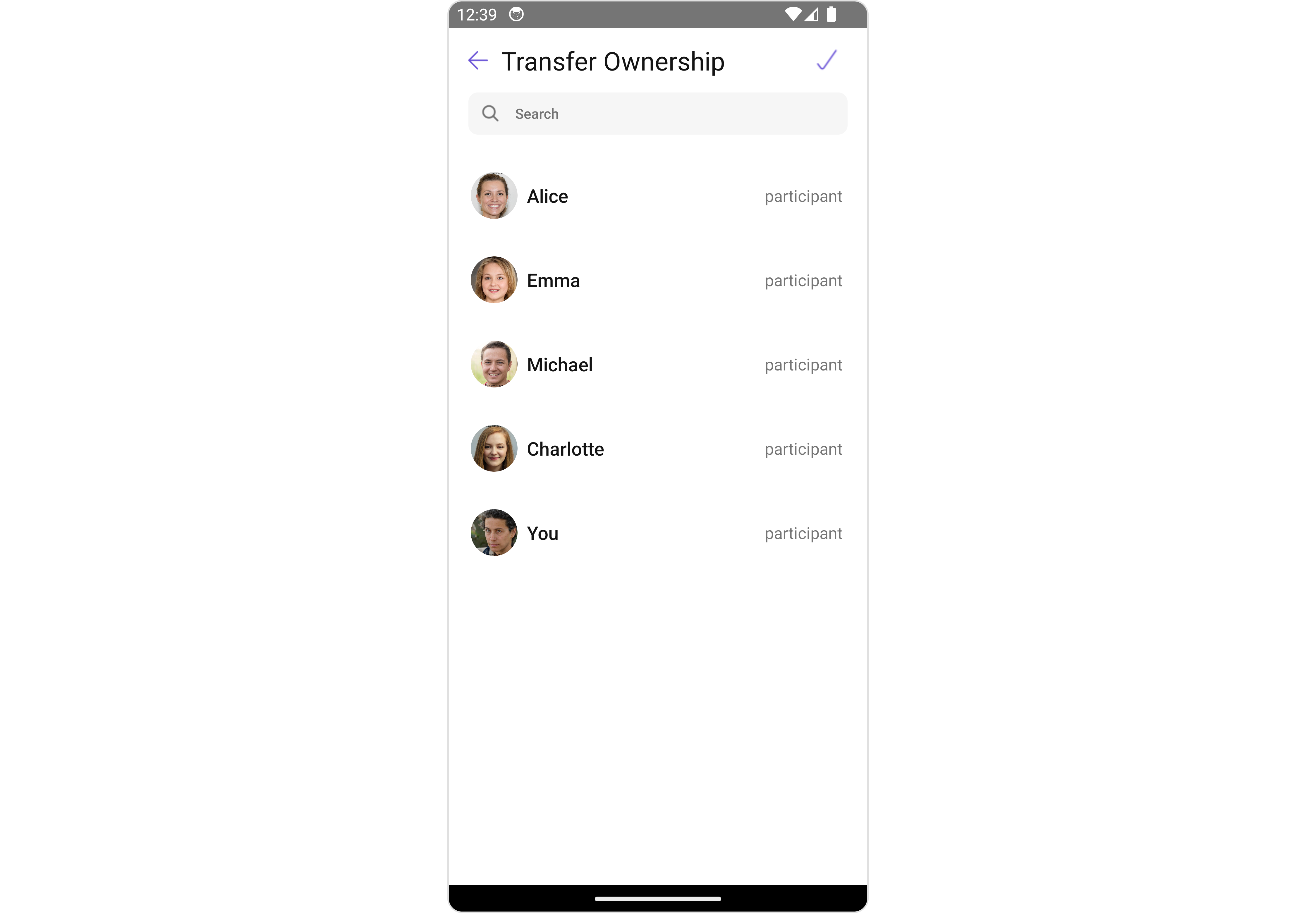
Usage
Integration
The following code snippet illustrates how you can directly incorporate the Transfer Ownership component into your Application.
- App.tsx
import { CometChat } from "@cometchat/chat-sdk-react-native";
import { CometChatTransferOwnership } from "@cometchat/chat-uikit-react-native";
function App(): React.JSX.Element {
const [group, setGroup] = useState<CometChat.Group | undefined>(undefined);
const getGroup = async () => {
const group = await CometChat.getGroup("guid");
setGroup(group);
};
useEffect(() => {
//login
getGroup();
});
return (
<>
{group && (
<CometChatTransferOwnership group={group}></CometChatTransferOwnership>
)}
</>
);
}
Actions
Actions dictate how a component functions. They are divided into two types: Predefined and User-defined. You can override either type, allowing you to tailor the behavior of the component to fit your specific needs.
1. onTransferOwnership
The onTransferOwnership action is activated when you make a selection and press the done icon. This action takes place after the ownership has been transferred.
This action does not come with any predefined behavior. However, you have the flexibility to override this event and tailor it to suit your needs using the following code snippet.
- App.tsx
import { CometChat } from "@cometchat/chat-sdk-react-native";
import { CometChatTransferOwnership } from "@cometchat/chat-uikit-react-native";
function App(): React.JSX.Element {
const [group, setGroup] = useState<CometChat.Group | undefined>(undefined);
const getGroup = async () => {
const group = await CometChat.getGroup("guid");
setGroup(group);
};
useEffect(() => {
//login
getGroup();
});
const onTransferOwnershipHandler = (
group: CometChat.Group,
ownershipTransferredMember: CometChat.User
) => {
//code
};
return (
<>
{group && (
<CometChatTransferOwnership
group={group}
onTransferOwnership={onTransferOwnershipHandler}
></CometChatTransferOwnership>
)}
</>
);
}
2. OnBack
OnBack is triggered when you click on the back button of the Transfer Ownership component. You can override this action using the following code snippet.
- App.tsx
import { CometChat } from "@cometchat/chat-sdk-react-native";
import { CometChatTransferOwnership } from "@cometchat/chat-uikit-react-native";
function App(): React.JSX.Element {
const [group, setGroup] = useState<CometChat.Group | undefined>(undefined);
const getGroup = async () => {
const group = await CometChat.getGroup("guid");
setGroup(group);
};
useEffect(() => {
//login
getGroup();
});
const onBackHandler = () => {
//code
};
return (
<>
{group && (
<CometChatTransferOwnership
group={group}
onBack={onBackHandler}
></CometChatTransferOwnership>
)}
</>
);
}
3. onError
This action doesn't change the behavior of the component but rather listens for any errors that occur in the Transfer Ownership component.
- App.tsx
import { CometChat } from "@cometchat/chat-sdk-react-native";
import { CometChatTransferOwnership } from "@cometchat/chat-uikit-react-native";
function App(): React.JSX.Element {
const [group, setGroup] = useState<CometChat.Group | undefined>(undefined);
const getGroup = async () => {
const group = await CometChat.getGroup("guid");
setGroup(group);
};
useEffect(() => {
//login
getGroup();
});
const onErrorHandler = (error: CometChat.CometChatException) => {
//code
};
return (
<>
{group && (
<CometChatTransferOwnership
group={group}
onError={onErrorHandler}
></CometChatTransferOwnership>
)}
</>
);
}
Filters
Filters allow you to customize the data displayed in a list within a Component. You can filter the list based on your specific criteria, allowing for a more customized. Filters can be applied using RequestBuilders of Chat SDK.
1. GroupMembersRequestBuilder
The GroupMembersRequestBuilder enables you to filter and customize the group members list based on available parameters in GroupMembersRequestBuilder. This feature allows you to create more specific and targeted queries when fetching groups. The following are the parameters available in GroupMembersRequestBuilder
| Methods | Type | Description |
|---|---|---|
| setLimit | number | sets the number of group members that can be fetched in a single request, suitable for pagination |
| setSearchKeyword | string | used for fetching group members matching the passed string |
| setScopes | Array<string> | used for fetching group members based on multiple scopes |
Example
In the example below, we are applying a filter to the Group Members by setting the limit to two and setting the scope to show only admin and moderator.
- App.tsx
import { CometChat } from "@cometchat/chat-sdk-react-native";
import { CometChatTransferOwnership } from "@cometchat/chat-uikit-react-native";
function App(): React.JSX.Element {
const [group, setGroup] = useState<CometChat.Group | undefined>(undefined);
let groupMemberRequestBuilder;
const getGroup = async () => {
const group = await CometChat.getGroup("mrc-uid");
groupMemberRequestBuilder = new CometChat.GroupMembersRequestBuilder(
group.getGuid()
).setScopes(["admin"]);
setGroup(group);
};
useEffect(() => {
//login
getGroup();
});
const onErrorHandler = (error: CometChat.CometChatException) => {
//code
};
return (
<>
{group && (
<CometChatTransferOwnership
group={group}
groupMemberRequestBuilder={groupMemberRequestBuilder}
></CometChatTransferOwnership>
)}
</>
);
}
2. SearchRequestBuilder
The SearchRequestBuilder uses GroupMembersRequestBuilder enables you to filter and customize the search list based on available parameters in GroupMembersRequestBuilder. This feature allows you to keep uniformity between the displayed Group Members List and searched Group Members List.
Example
- App.tsx
import { CometChat } from "@cometchat/chat-sdk-react-native";
import { CometChatTransferOwnership } from "@cometchat/chat-uikit-react-native";
function App(): React.JSX.Element {
const [group, setGroup] = useState<CometChat.Group | undefined>(undefined);
let searchRequestBuilder;
const getGroup = async () => {
const group = await CometChat.getGroup("mrc-uid");
searchRequestBuilder = new CometChat.GroupMembersRequestBuilder(
group.getGuid()
)
.setScopes(["admin"])
.setSearchKeyword("some-search-keyword");
setGroup(group);
};
useEffect(() => {
//login
getGroup();
});
return (
<>
{group && (
<CometChatTransferOwnership
group={group}
groupMemberRequestBuilder={searchRequestBuilder}
></CometChatTransferOwnership>
)}
</>
);
}
Events
Events are emitted by a Component. By using event you can extend existing functionality. Being global events, they can be applied in Multiple Locations and are capable of being Added or Removed.
Events emitted by the Add Members component is as follows.
| Event | Description |
|---|---|
| ccOwnershipChanged | Triggers when the group ownership is successfully transferred |
- Adding Listeners
import { CometChatUIEventHandler } from "@cometchat/chat-uikit-react-native";
CometChatUIEventHandler.addGroupListener("GROUP_LISTENER_ID", {
ccOwnershipChanged: ({ group, message }) => {
//code
},
});
- Removing Listeners
import { CometChatUIEventHandler } from "@cometchat/chat-uikit-react-native";
CometChatUIEventHandler.removeGroupListener("GROUP_LISTENER_ID");
Customization
To fit your app's design requirements, you can customize the appearance of the Groups component. We provide exposed methods that allow you to modify the experience and behavior according to your specific needs.
Style
Using Style you can customize the look and feel of the component in your app, These parameters typically control elements such as the color, size, shape, and fonts used within the component.
1. GroupMember Style
You can set the GroupMemberStyle to the Transfer Ownership Component to customize the styling. For further insights on GroupMember Styles refer
- App.tsx
import { CometChat } from "@cometchat/chat-sdk-react-native";
import {
CometChatTransferOwnership,
GroupMembersStyleInterface,
} from "@cometchat/chat-uikit-react-native";
function App(): React.JSX.Element {
const [group, setGroup] = useState<CometChat.Group | undefined>(undefined);
const getGroup = async () => {
const group = await CometChat.getGroup("mrc-uid");
setGroup(group);
};
useEffect(() => {
//login
getGroup();
});
const groupMemberStyle: GroupMembersStyleInterface = {
titleColor: "red",
backgroundColor: "#d2cafa",
};
return (
<>
{group && (
<CometChatTransferOwnership
group={group}
groupMemberStyle={groupMemberStyle}
></CometChatTransferOwnership>
)}
</>
);
}
2. Avatar Style
To apply customized styles to the Avatar component in the Banned Members Component, you can use the following code snippet. For further insights on Avatar Styles refer
- App.tsx
import { CometChat } from "@cometchat/chat-sdk-react-native";
import {
CometChatTransferOwnership,
AvatarStyleInterface,
} from "@cometchat/chat-uikit-react-native";
function App(): React.JSX.Element {
const [group, setGroup] = useState<CometChat.Group | undefined>(undefined);
const getGroup = async () => {
const group = await CometChat.getGroup("mrc-uid");
setGroup(group);
};
useEffect(() => {
//login
getGroup();
});
const avatarStyle: AvatarStyleInterface = {
outerViewSpacing: 5,
outerView: {
borderWidth: 2,
borderStyle: "dotted",
borderColor: "blue",
},
border: borderStyle,
};
return (
<>
{group && (
<CometChatTransferOwnership
group={group}
avatarStyle={avatarStyle}
></CometChatTransferOwnership>
)}
</>
);
}
3. ListItem Style
To apply customized styles to the ListItemStyle component in the Banned Members Component, you can use the following code snippet. For further insights on ListItemStyle Styles refer
- App.tsx
import { CometChat } from "@cometchat/chat-sdk-react-native";
import {
CometChatTransferOwnership,
ListItemStyleInterface,
} from "@cometchat/chat-uikit-react-native";
function App(): React.JSX.Element {
const [group, setGroup] = useState<CometChat.Group | undefined>(undefined);
const getGroup = async () => {
const group = await CometChat.getGroup("guid");
setGroup(group);
};
useEffect(() => {
//login
getGroup();
});
const listItemStyle: ListItemStyleInterface = {
titleColor: "red",
backgroundColor: "#d2cafa",
};
return (
<>
{group && (
<CometChatTransferOwnership
group={group}
listItemStyle={listItemStyle}
></CometChatTransferOwnership>
)}
</>
);
}
4. StatusIndicator Style
To apply customized styles to the Status Indicator component in the Banned Members Component, You can use the following code snippet. For further insights on Status Indicator Styles refer
- App.tsx
import { CometChat } from "@cometchat/chat-sdk-react-native";
import {
CometChatTransferOwnership,
StatusIndicatorStyleInterface,
} from "@cometchat/chat-uikit-react-native";
function App(): React.JSX.Element {
const [group, setGroup] = useState<CometChat.Group | undefined>(undefined);
const getGroup = async () => {
const group = await CometChat.getGroup("guid");
setGroup(group);
};
useEffect(() => {
//login
getGroup();
});
const statusIndicatorStyle: StatusIndicatorStyleInterface = {
backgroundColor: "grey",
};
return (
<>
{group && (
<CometChatTransferOwnership
group={group}
statusIndicatorStyle={statusIndicatorStyle}
></CometChatTransferOwnership>
)}
</>
);
}
Functionality
These are a set of small functional customizations that allow you to fine-tune the overall experience of the component. With these, you can change text, set custom icons, and toggle the visibility of UI elements.
- App.tsx
import { CometChat } from "@cometchat/chat-sdk-react-native";
import { CometChatTransferOwnership } from "@cometchat/chat-uikit-react-native";
function App(): React.JSX.Element {
const [group, setGroup] = useState<CometChat.Group | undefined>(undefined);
const getGroup = async () => {
const group = await CometChat.getGroup("guid");
setGroup(group);
};
useEffect(() => {
//login
getGroup();
});
return (
<>
{group && (
<CometChatTransferOwnership
group={group}
title="Custom Title"
></CometChatTransferOwnership>
)}
</>
);
}
- iOS
- Android
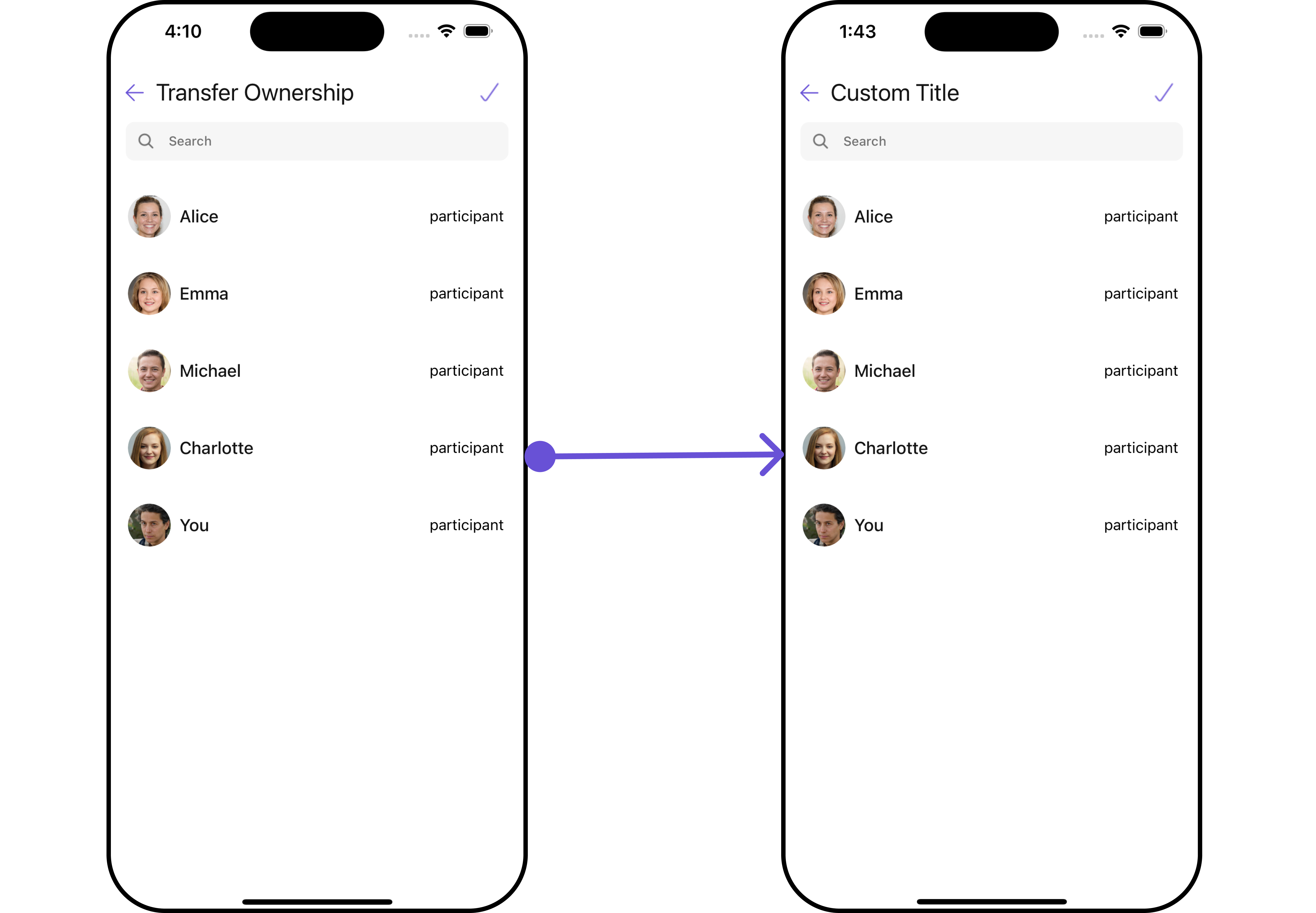

Advance
For advanced-level customization, you can set custom views to the component. This lets you tailor each aspect of the component to fit your exact needs and application aesthetics. You can create and define your views, layouts, and UI elements and then incorporate those into the component.
ListItemView
With this property, you can assign a custom ListItemView to the Transfer Ownership Component.
Example
- iOS
- Android
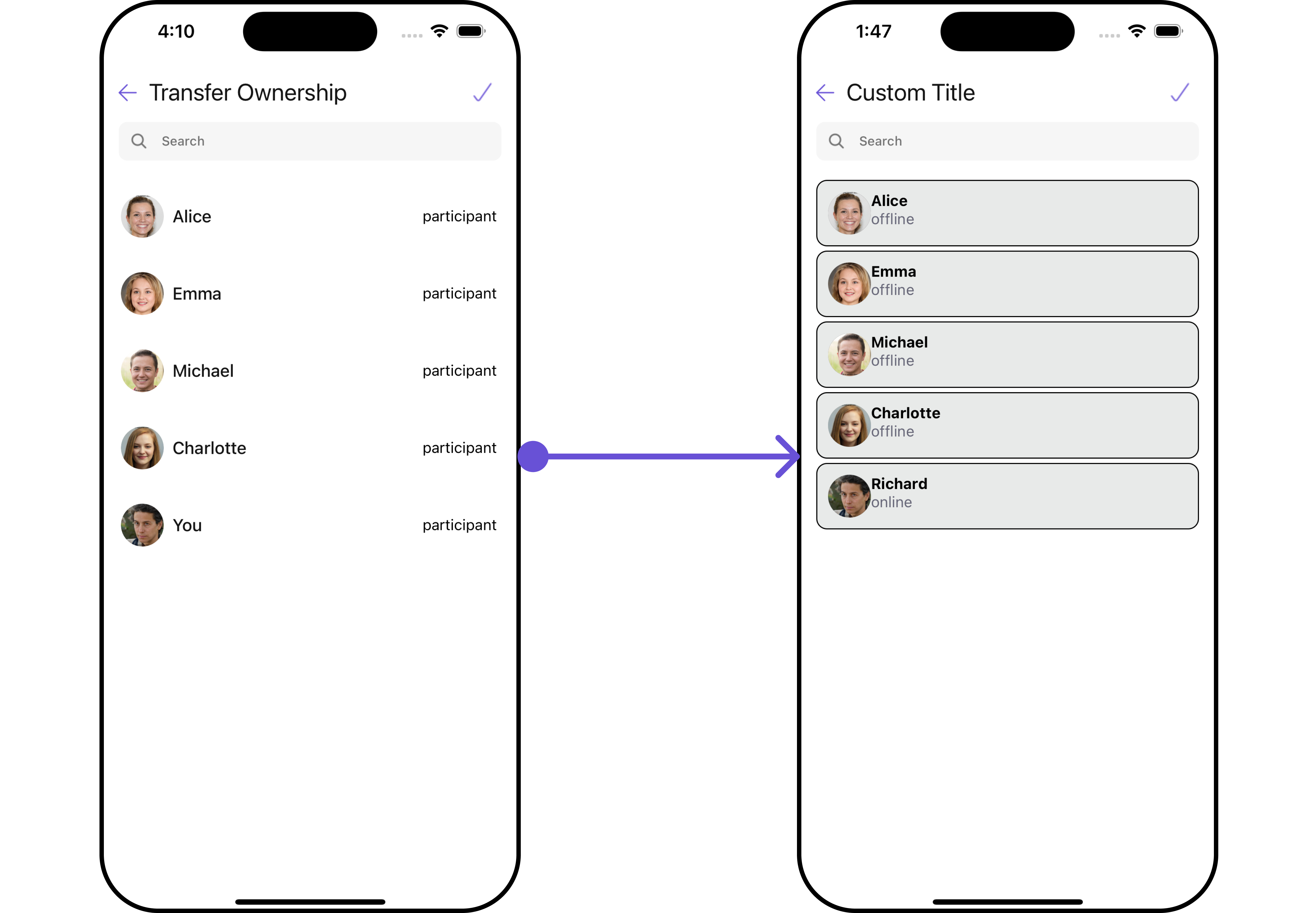
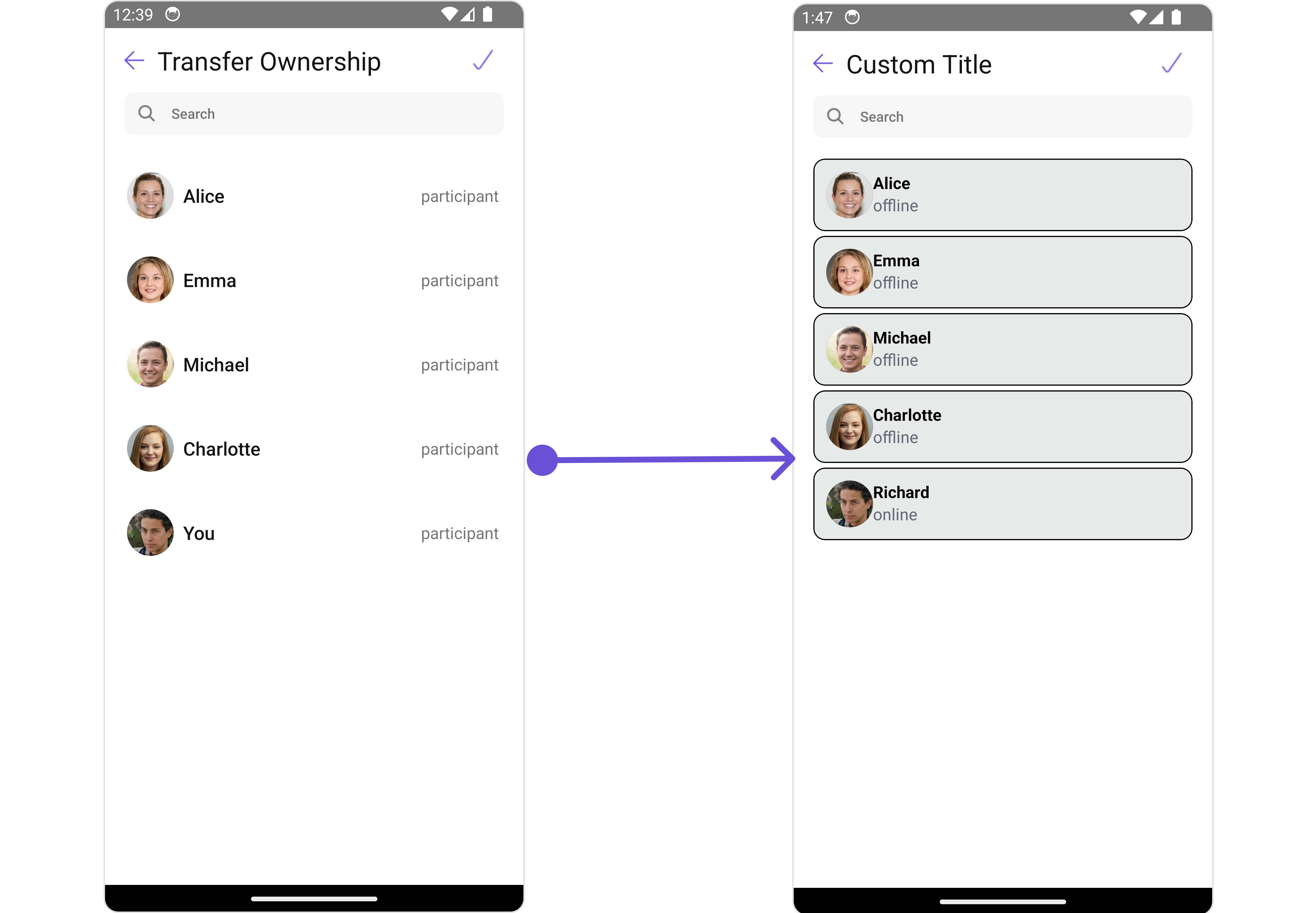
- App.tsx
import { CometChat } from "@cometchat/chat-sdk-react-native";
import { CometChatTransferOwnership } from "@cometchat/chat-uikit-react-native";
function App(): React.JSX.Element {
const [group, setGroup] = useState<CometChat.Group | undefined>(undefined);
const getGroup = async () => {
const group = await CometChat.getGroup("guid");
setGroup(group);
};
useEffect(() => {
//login
getGroup();
});
const viewStyle: StyleProp<ViewStyle> = {
flex: 1,
flexDirection: "row",
alignItems: "flex-start",
padding: 10,
borderColor: "black",
borderWidth: 1,
backgroundColor: "#E8EAE9",
borderRadius: 10,
margin: 2,
};
const getListItemView = (user: any) => {
return (
<View style={viewStyle}>
<CometChatAvatar
image={user.avatar ? { uri: user.avatar } : undefined}
name={user.name}
/>
<View>
<Text style={{ color: "black", fontWeight: "bold" }}>
{user.name}
</Text>
<Text style={{ color: "#667" }}>{user.status}</Text>
</View>
</View>
);
};
return (
<>
{group && (
<CometChatTransferOwnership
group={group}
title="Custom Title"
ListItemView={getListItemView}
></CometChatTransferOwnership>
)}
</>
);
}
SubtitleView
You can customize the SubtitleView view for each banned members to meet your requirements
- iOS
- Android
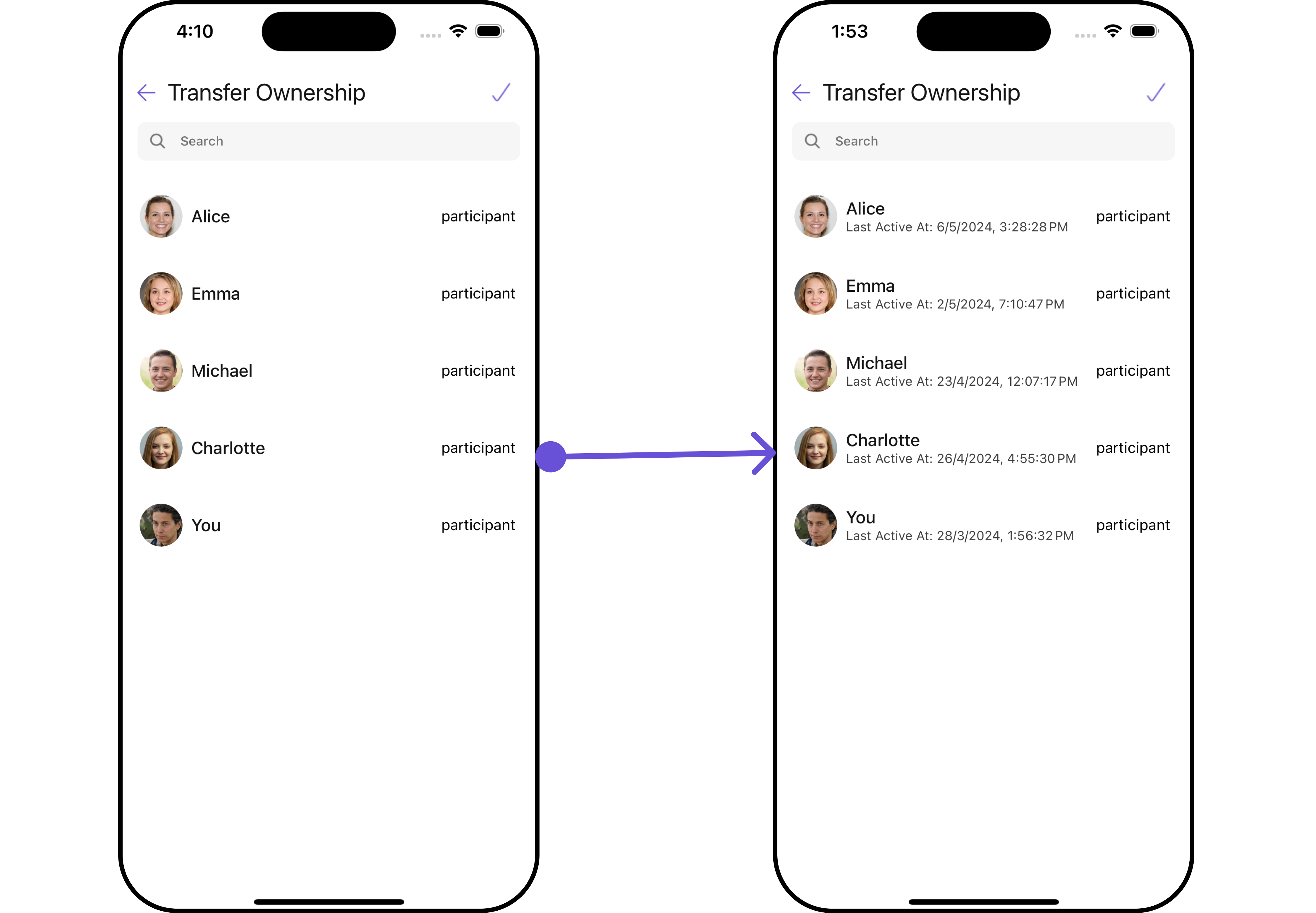
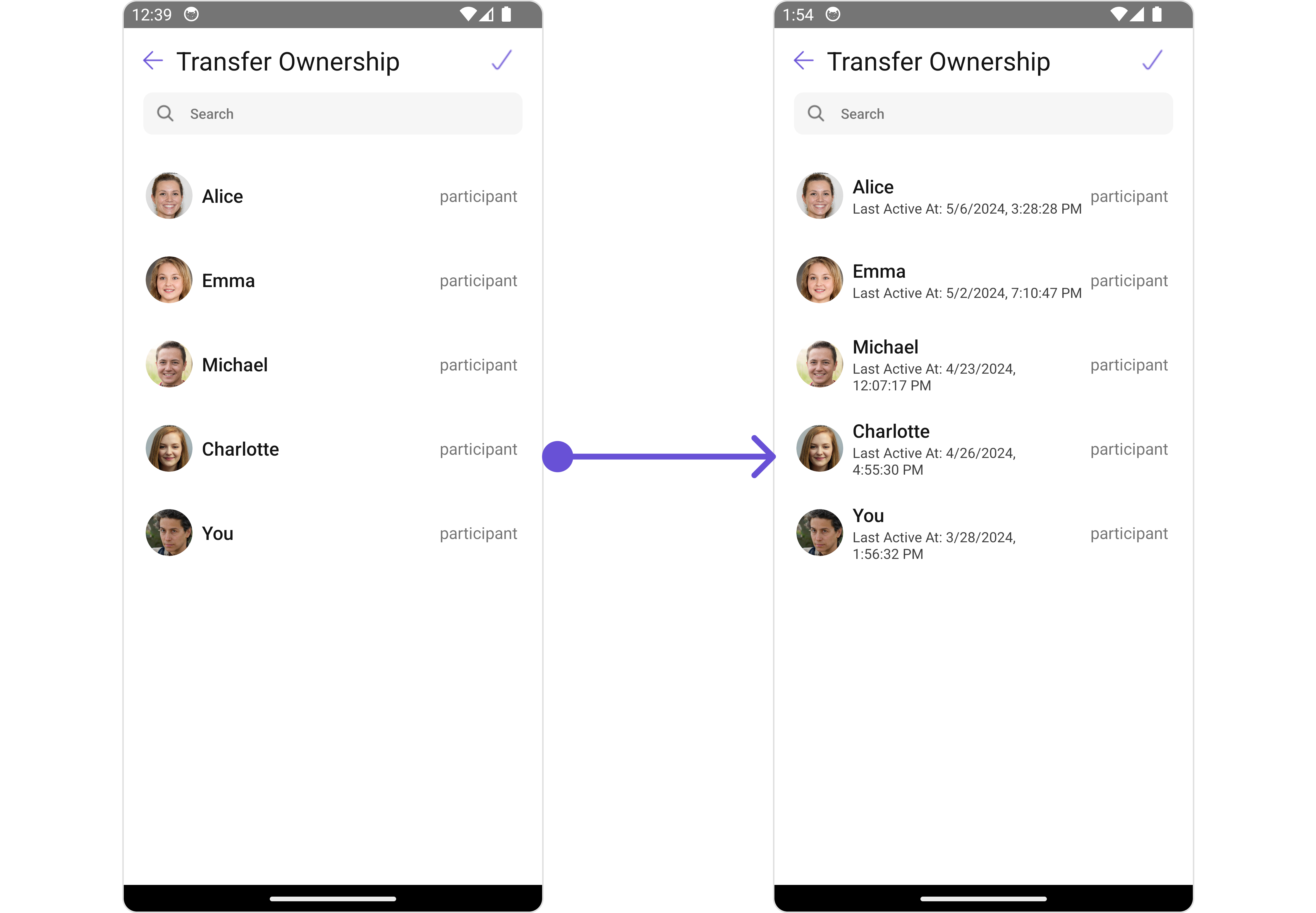
- App.tsx
import { CometChat } from "@cometchat/chat-sdk-react-native";
import { CometChatTransferOwnership } from "@cometchat/chat-uikit-react-native";
function App(): React.JSX.Element {
const [group, setGroup] = useState<CometChat.Group | undefined>(undefined);
const getGroup = async () => {
const group = await CometChat.getGroup("guid");
setGroup(group);
};
useEffect(() => {
//login
getGroup();
});
const getSubtitleView = (user) => {
return (
<Text
style={{
fontSize: 12,
color: theme.palette.getAccent800(),
}}
>
Last Active At:{" "}
{user?.lastActiveAt ? formatTime(user?.lastActiveAt) : "--"}
</Text>
);
};
const getSubtitleView = (user) => {
return (
<Text
style={{
fontSize: 12,
color: theme.palette.getAccent800(),
}}
>
Last Active At:{" "}
{user?.lastActiveAt ? formatTime(user?.lastActiveAt) : "--"}
</Text>
);
};
return (
<>
{group && (
<CometChatTransferOwnership
group={group}
SubtitleView={getSubtitleView}
></CometChatTransferOwnership>
)}
</>
);
}
LoadingStateView
You can set a custom loader view using LoadingStateView to match the loading view of your app.
- iOS
- Android
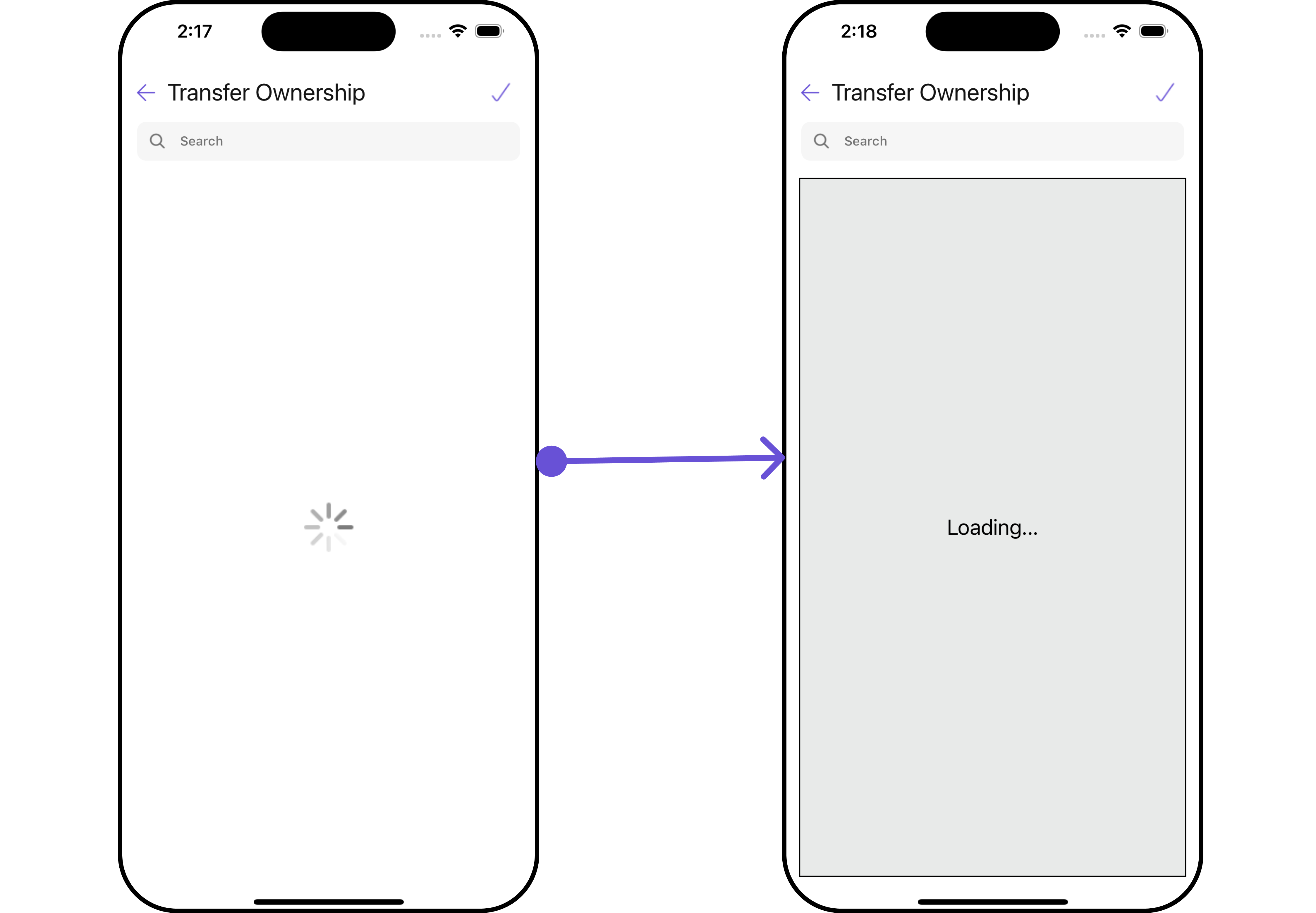
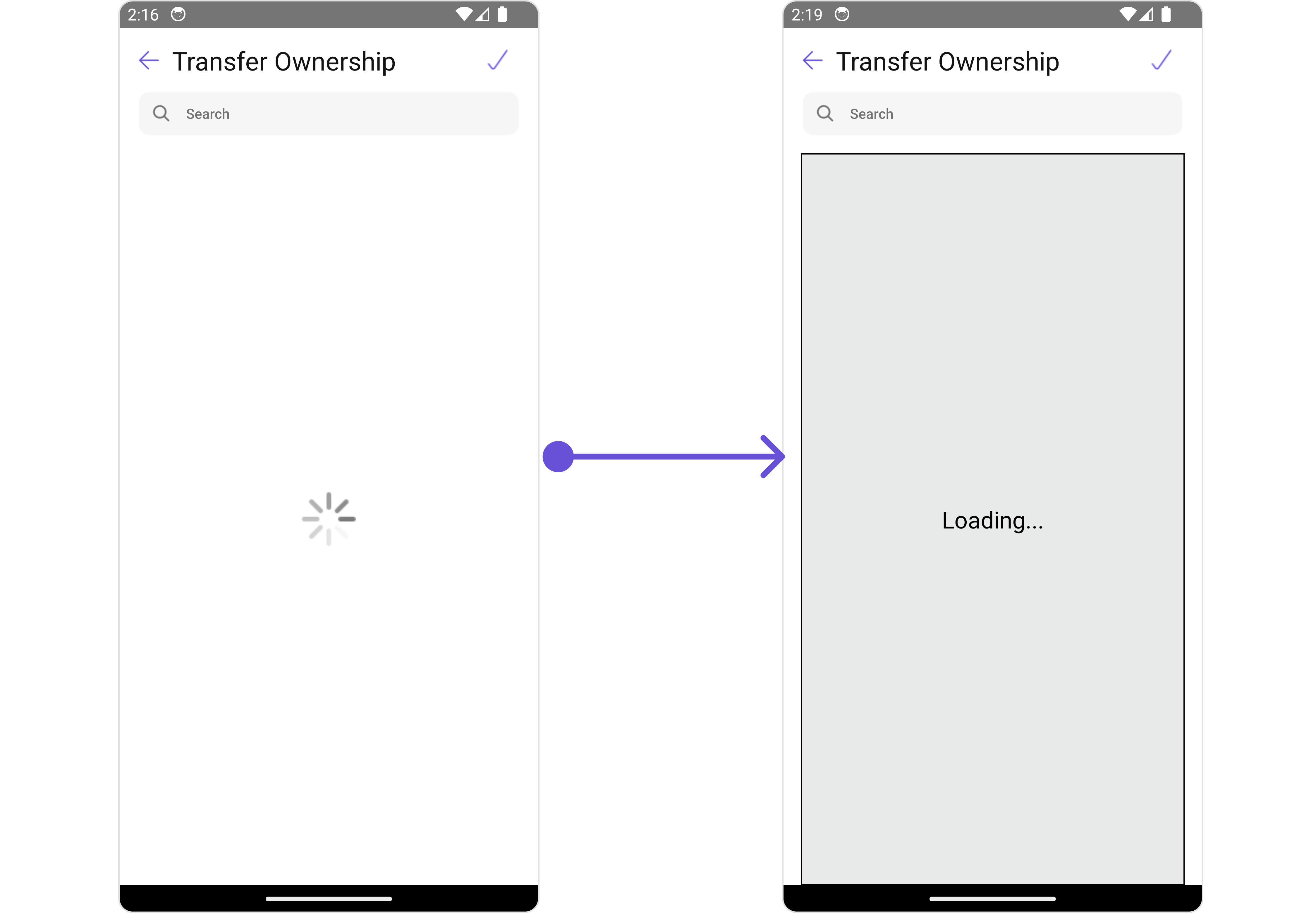
- App.tsx
import { CometChat } from "@cometchat/chat-sdk-react-native";
import { CometChatTransferOwnership } from "@cometchat/chat-uikit-react-native";
function App(): React.JSX.Element {
const [group, setGroup] = useState<CometChat.Group | undefined>(undefined);
const getGroup = async () => {
const group = await CometChat.getGroup("guid");
setGroup(group);
};
useEffect(() => {
//login
getGroup();
});
const loadingViewStyle: StyleProp<ViewStyle> = {
flex: 1,
alignItems: "center",
justifyContent: "center",
padding: 10,
borderColor: "black",
borderWidth: 1,
backgroundColor: "#E8EAE9",
};
const getLoadingStateView = () => {
return (
<View style={loadingViewStyle}>
<Text style={{ fontSize: 20, color: "black" }}>Loading...</Text>
</View>
);
};
return (
<>
{group && (
<CometChatTransferOwnership
group={group}
LoadingStateView={getLoadingStateView}
></CometChatTransferOwnership>
)}
</>
);
}
EmptyStateView
You can set a custom EmptyStateView using EmptyStateView to match the empty view of your app.
- App.tsx
import { CometChat } from "@cometchat/chat-sdk-react-native";
import { CometChatTransferOwnership } from "@cometchat/chat-uikit-react-native";
function App(): React.JSX.Element {
const [group, setGroup] = useState<CometChat.Group | undefined>(undefined);
const getGroup = async () => {
const group = await CometChat.getGroup("guid");
setGroup(group);
};
useEffect(() => {
//login
getGroup();
});
const searchRequestBuilder = new CometChat.UsersRequestBuilder()
.setLimit(100)
.setSearchKeyword("does-not-exist");
const emptyViewStyle: StyleProp<ViewStyle> = {
flex: 1,
alignItems: "center",
justifyContent: "center",
padding: 10,
borderColor: "black",
borderWidth: 1,
backgroundColor: "#E8EAE9",
};
const getEmptyStateView = () => {
return (
<View style={emptyViewStyle}>
<Text style={{ fontSize: 80, color: "black" }}>Empty</Text>
</View>
);
};
return (
<>
{group && (
<CometChatTransferOwnership
group={group}
searchRequestBuilder={searchRequestBuilder}
EmptyStateView={getEmptyStateView}
></CometChatTransferOwnership>
)}
</>
);
}